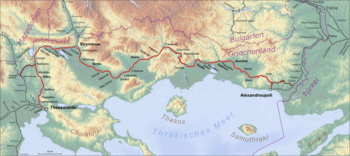Thessaloniki–Alexandroupoli railway
The Thessaloniki–Alexandroupoli railway is an about 440 km long railway in northern Greece connecting the Central Macedonian city of Thessaloniki with Alexandroupoli in Eastern Macedonia and Thrace, via Serres. At the Strymonas station there is a connection towards Sofia. As of 2015, there is regular passenger service to Alexandroupoli with connecting services to Dikaia, as well as international services to Sofia and via Skopje to Belgrade, while the international service to Istanbul ("Friendship Express") remains suspended.
Course
The western terminus of the Thessaloniki–Svilengrad railway is the New Railway Station, Thessaloniki. It runs north passing Kilkis, until it turns east at the shore of Dojran Lake. It runs along the north shore of Lake Kerkini, and crosses the river Strymonas near Sidirokastro. The line north to Sofia (border crossing Promachonas/Kulata) branches off here. The railway continues east along Serres and Drama. It crosses the river Nestos at Paranesti, and follows it until Toxotes. It passes Xanthi and Komotini, and reaches the Aegean Sea at Alexandroupoli, where it ends at the Alexandroupoli railway station, which is further connected to Pythio via the Alexandroupoli–Svilengrad railway.
History
In October 1892 the Société du Chemin de Fer Ottoman Jonction Salonique-Constantinople, abbreviated JSC, was founded. It had the task to build a rail link between Thessaloniki and Istanbul. The company was formed according to Ottoman law with headquarters in Paris. Its task was to build and operate a 442 km long line between Thessaloniki and Alexandroupoli, at that time still called Dedeagatch. From there the route to Istanbul continued over the Chemins de fer Orientaux via Pythio on the main line Edirne–Istanbul.
The line had the strategique task to connect Thessaloniki with the rest of the Ottoman Empire without touching Serbian or Bulgarian territory. Thessaloniki was already since 1888 connected with Istanbul by the Chemins de fer Orientaux, but this connection went through the before mentioned countries, which were once part of the Ottoman Empire but split off at a later stage.
The line was carefully built away from the border and the coast to avoid destruction by warfare. Except near Alexandroupoli the minimum distance from enemy countries and sea was 15 km in oder to keep the route out of artillery and gun boat fire reach. Alexandroupoli received at a later stage a bypass route in the North of the town fulfilling the original requirement. This route had several horseshoe curves to master the steep grades in the geographic wise difficult country and is today closed and razed. Also Thessaloniki received a Norther bypass, which connected the station Kallindria with Karasuli on the line to Mitrovica.
Under the guidance of the Ministry of War the concessionaires were obliged to build 26 stations. Some of them were military stations equipped with all the necessary facilities for the prompt embarkation and disembarkation of troops and war material.
Furthermore, the company was obliged to own and maintain at least 818 wagons; namely: 90 passenger carriages of three classes; 30 baggage wagons; 528 boxcars; 200 gondolas. The boxcars and gondolas must be capable of transporting troops, horses and cattle, guns, etc., so that 27 complete trains can be organised – one more train than the number of stations. For the transport of soldiers, 130 of the 200 gondolas should be capable to be covered as quick as possible if required. Furthermore, the railway had to keep sufficient benches in the store to allow the soldiers to sit during the transport.[2]
The line was opened in the years 1894 and 1895. As a result of the Balkan Wars, the 143 km long route from Alexandroupoli to Okschilar came to Bulgaria, the routes Okschilar–Thessaloniki came to Greece. The Bulgarian piece has been incorporated into the Bulgarian state railways since October 1915, while the Greek piece was integrated in the Greek state railways.[3]
Services
The Thessaloniki–Alexandroupoli railway is used by the following passenger services:
- Intercity and regular services Thessaloniki–Alexandroupoli[4]
References
- 1 2 3 "OSE - 2017 Network Statement Annexes". p. 5.
- ↑ "Chemin de Fer Ottoman Jonction Salonique-Constantinople (JSC)" (PDF). Les entreprises coloniales françaises. 2016-09-13.
- ↑ Zeno. "Türkische Eisenbahnen". www.zeno.org (in German). Retrieved 2018-07-05.
- ↑ "2014/15 Intercity schedule" (PDF). TrainOSE. Retrieved 11 March 2015.
